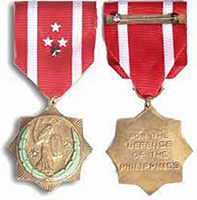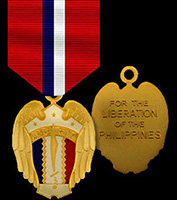Philippines
Japan launched an attack on the Philippines on December 8, 1941, a mere 10 hours after their attack on Pearl Harbor. An initial bombardment was followed by troop landings both north and south of Manila. Defending Allied forces were forced to withdraw to the Bataan Peninsula and the island of Corregidor. To prevent its destruction, Manila declared itself an "open" city and was occupied by Japanese forces on January 2, 1942.
The Philippine Defense Medal is a military of the Republic of the Philippines, which was awarded to recognize the initial resistance against Japanese invasion between the dates of December 8, 1941 and June 15, 1942. The award was first created in December 1944 and was issued as the Philippine Defense Ribbon. A full-sized medal was authorized and added during July 1945.


Philippines Defense Medal and Liberation Medal
The 39mm bronze-gilt medal is in the shape of an eight-pointed star. The central figure on the obverse is a female warrior standing on a pedestal with a bow and arrow beneath three gilt stars. The figure is surrounded by a wreath-like design of 20 small green-enamel rectangles. The reverse is inscribed on four straight lines FOR THE DEFENSE OF THE PHILIPPINES.
The Philippine Liberation Medal is a decoration presented by the Republic of the Philippines to recognize members of the Philippine Commonwealth military and Allied forces, who served during the liberation of the Philippine Islands between October 17, 1944 and September 2, 1945. To be eligible, personnel must have: (1) been a member of the Bataan or Manila Bay Forces or served in a unit, aircraft, or ship under attack or (2) been assigned or stationed in the Philippine territory for at least 30 days between December 8, 1941 to June 15, 1947. Service members who participated in either of the two operations mentioned above are also eligible for a Service Star to be worn as an attachment on the ribbon drape.
The 37.5mm bronze-gilt Liberation Medal is designed as a Philippines War Shield flanked by the Wings of Victory, embellished by vertical panels of blue, white, and red enamel. Superimposed on the white enamel center panel is a silver Bolo knife, tip up. Above the three panels is the inscription LIBERTY and above that a white enamel panel with three five-pointed stars in yellow enamel. There are at least three different suspension devices. Like the Defense Medal, this award was issued as the Philippine Liberation Ribbon. A full-sized medal was authorized and added during July 1945. The reverse is inscribed on four straight lines FOR THE LIBERATION OF THE PHILIPPINES.
Japan launched an attack on the Philippines on December 8, 1941, a mere 10 hours after their attack on Pearl Harbor. An initial bombardment was followed by troop landings both north and south of Manila. Defending Allied forces were forced to withdraw to the Bataan Peninsula and the island of Corregidor. To prevent its destruction, Manila declared itself an "open" city and was occupied by Japanese forces on January 2, 1942.
The Philippine Defense Medal is a military of the Republic of the Philippines, which was awarded to recognize the initial resistance against Japanese invasion between the dates of December 8, 1941 and June 15, 1942. The award was first created in December 1944 and was issued as the Philippine Defense Ribbon. A full-sized medal was authorized and added during July 1945.


Philippines Defense Medal and Liberation Medal
The 39mm bronze-gilt medal is in the shape of an eight-pointed star. The central figure on the obverse is a female warrior standing on a pedestal with a bow and arrow beneath three gilt stars. The figure is surrounded by a wreath-like design of 20 small green-enamel rectangles. The reverse is inscribed on four straight lines FOR THE DEFENSE OF THE PHILIPPINES.
The Philippine Liberation Medal is a decoration presented by the Republic of the Philippines to recognize members of the Philippine Commonwealth military and Allied forces, who served during the liberation of the Philippine Islands between October 17, 1944 and September 2, 1945. To be eligible, personnel must have: (1) been a member of the Bataan or Manila Bay Forces or served in a unit, aircraft, or ship under attack or (2) been assigned or stationed in the Philippine territory for at least 30 days between December 8, 1941 to June 15, 1947. Service members who participated in either of the two operations mentioned above are also eligible for a Service Star to be worn as an attachment on the ribbon drape.
The 37.5mm bronze-gilt Liberation Medal is designed as a Philippines War Shield flanked by the Wings of Victory, embellished by vertical panels of blue, white, and red enamel. Superimposed on the white enamel center panel is a silver Bolo knife, tip up. Above the three panels is the inscription LIBERTY and above that a white enamel panel with three five-pointed stars in yellow enamel. There are at least three different suspension devices. Like the Defense Medal, this award was issued as the Philippine Liberation Ribbon. A full-sized medal was authorized and added during July 1945. The reverse is inscribed on four straight lines FOR THE LIBERATION OF THE PHILIPPINES.
Website Maintained by Keith Emroll